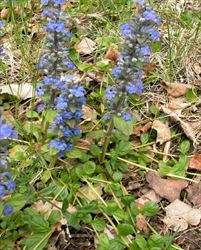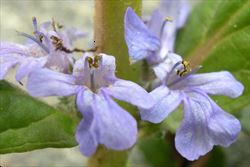Click on images to enlarge

habit (Photo: Greg Jordan)

leaves (Photo: Sheldon Navie)

creeping stems (Photo: Sheldon Navie)

flowers clustered into upright elongated spikes (Photo: Sheldon Navie)

close-up of flowers (Photo: Greg Jordan)

close-up of seeds (Photo: Steve Hurst at USDA PLANTS Database)

Australian bugle (Ajuga australis), a similar native plant with flowers clustered in the upper leaf forks (Photo: Sheldon Navie)
Scientific Name
Ajuga reptans L.
Family
Labiatae (South Australia)Lamiaceae (Queensland, New South Wales, the ACT, Victoria, Tasmania, Western Australia and the Northern Territory)
Common Names
ajuga, blue bugle, bugle, bugle flower, bugle weed, bugleherb, bugleweed, carpet bugle, carpetbugle, carpet bugleweed, carpetweed, common bugle, creeping bugleweed, European bugle
Origin
Native to north-western Africa (i.e. northern Algeria and Tunisia), Europe and western Asia (i.e. northern Iran, northern Turkey, Azerbaijan, Georgia and southern Russia.
Naturalised Distribution
Naturalised in some parts of south-eastern Australia (i.e. in Tasmania, in the Central Tablelands region in sub-coastal New South Wales, and sparingly naturalised in Victoria).
Also naturalised in the USA, Canada and New Zealand.
Notes
This species is regarded as an environmental weed in Tasmania. Common bugle (Ajuga reptans) was first recorded in this state in 1978, and is now locally naturalised in the western and south-western parts of Tasmania. It is very common as an ornamental groundcover in the temperate regions of Australia, with several cultivars being available. However, it is considered to be a garden plant with a high risk of invading native vegetation in Tasmania. It has already escaped cultivation and is weedy on roadsides and along creeks.
Common bugle (Ajuga reptans) has also recently been recorded as naturalised in damp areas in the upper Blue Mountains in central New South Wales. In this region it is spreading from existing plantings by creeping stems (i.e. stolons) and by the movement of stem sections along watercourses, and has been spotted in the Blackheath, Katoomba and South Leura areas. It is also regarded as a potential environmental weed in Gosford City, on the New South Wales central coast, and at Falls Creek in north-eastern Victoria.

